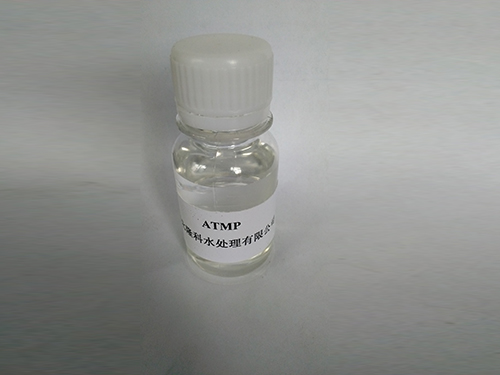Amino Trimethylene Phosphonic Acid ATMP Scale Inhibitor

Amino Trimethylene Phosphonic Acid (ATMP)
CAS No.: 6419-19-8
ATMP is a nitrogenous organic polyphosphonic acid that demonstrates exceptional scale and corrosion inhibition capabilities. Recognized as one of the most effective phosphonic acids in industrial water treatment, ATMP maintains thermal stability under high-temperature conditions (up to 200°C) and exhibits strong tolerance to chlorine oxidation.
Key Applications:
- Cooling water treatment systems
- Oilfield water injection systems
- Metal surface treatment processes
- Reverse osmosis membrane cleaning
- Industrial detergent formulations
Technical Specifications of Amino Trimethylene Phosphonic Acid (ATMP)
| Parameter | Industrial Grade | High Purity Grade | Testing Method |
|---|---|---|---|
| Active Content (%) | 50.0 ± 0.5 | ≥ 95.0 | Potentiometric titration |
| Phosphorus Content (PO₄³⁻%) | 28.0 - 30.0 | ≥ 53.0 | Spectrophotometric |
| pH (1% aqueous solution) | 1.5 - 2.0 | 1.5 - 2.0 | pH meter |
| Density (20°C g/cm³) | 1.35 - 1.45 | 1.45 - 1.55 | Densitometer |
| Chloride (Cl⁻%) | ≤ 0.5 | ≤ 0.05 | Ion chromatography |
Technical Performance Analysis
Industrial Applications of Amino Trimethylene Phosphonic Acid
Amino trimethylene phosphonic acid has revolutionized industrial water treatment through its multifunctional capabilities. Its molecular structure features three phosphonic acid groups connected to a central nitrogen atom, creating strong chelating properties with divalent metal ions (Ca²⁺, Mg²⁺, Fe²⁺).
Scale Inhibition Mechanism
ATMP disrupts crystal growth through:
- Threshold inhibition capacity (effective at 2-10 ppm)
- Distortion of calcium carbonate crystal lattice
- Synergistic effects with polymeric dispersants
Corrosion Protection
Creates protective film on metal surfaces:
- Anodic passivation of carbon steel
- Cathodic polarization barrier
- Oxygen scavenging capabilities
Environmental Advantages
- Phosphorus content: 53% vs 63% in conventional phosphates
- Biodegradation rate: 65-80% after 28 days
- Low aquatic toxicity (LC50 > 100 mg/L)
Technical FAQ: ATMP in Water Treatment
What's the recommended concentration ratio when formulating ATMP with zinc ions?
The optimal synergism occurs at ATMP:Zn²⁺ mass ratios between 3:1 to 5:1. Excessive zinc (>4 ppm) can reduce effectiveness through precipitation. At pH 7.0-8.5, this combination typically yields 85-92% corrosion inhibition efficiency on carbon steel.
How does chloride concentration affect ATMP performance?
High chloride (>500 ppm) accelerates localized pitting corrosion. ATMP formulations should be supplemented with complementary inhibitors like tolyltriazole (1-5 ppm) and molybdate (6-12 ppm). Field studies show optimal chloride:ATMP ratio below 300:1 to maintain protective film integrity.
What is the degradation pathway of ATMP in wastewater systems?
Amino trimethylene phosphonic acid undergoes photolytic decomposition (λ = 290 nm) and microbial breakdown. Primary degradation products include aminomethylene diphosphonic acid (AMDP) and ultimately orthophosphate. Typical half-life in aerobic conditions is 15-28 days depending on temperature and microbial activity.
What material compatibility concerns exist with ATMP solutions?
Concentrated ATMP (≥50%) requires CPVC, 316L stainless steel, or polyethylene storage. Avoid carbon steel and brass in undiluted solutions. Gasket materials should be PTFE or Viton; EPDM demonstrates superior compatibility (≤0.25% swell).
How to determine ATMP concentration in circulating water?
Use persulfate digestion (ISO 6878 method) with flow injection analysis. Orthophosphate concentrations must be measured before and after oxidative decomposition to calculate organophosphonate levels. Detection limit is 0.02 ppm ATMP with this methodology.
What's ATMP's performance threshold for silica scale control?
At pH 9.0, ATMP inhibits silica polymerization up to 250 ppm SiO₂ at dosage rates of 20-25 ppm. Combine with acrylic acid/sulfonate copolymers (5-10 ppm) for systems exceeding 300 ppm SiO₂. Maximum efficacy temperature is 60°C in high-silica waters.
What are regulatory considerations for ATMP discharge?
In OECD countries, ATMP requires aquatic toxicity monitoring (Daphnia magna EC50 > 100 mg/L). The EU Water Framework Directive limits discharge to 1 mg/L total phosphonates. US NPDES permits typically require biodegradability documentation meeting 28-day OECD 306 standards.
Research & Industry Perspectives
"ATMP demonstrates superior stabilization efficiency against calcium carbonate precipitation compared to conventional polyphosphates. In accelerated scaling tests (LSI=3.0, 70°C), our research shows ATMP dosage at 8ppm achieves equivalent inhibition to 28ppm HEDP while reducing total phosphorus load by 43%."
Recent advancements in amino trimethylene phosphonic acid formulations have focused on improving biodegradability through:
- Catalytic oxidation enhancement using TiO₂ photocatalysts
- Hybrid polymer systems with polyaspartic acid derivatives
- Microencapsulation for controlled release applications
The global scale inhibitor water treatment market incorporating phosphonates is projected to grow at 6.2% CAGR through 2030 (source: MarketsandMarkets™ Water Treatment Analysis), driven by stricter environmental regulations favoring phosphorus-based inhibitors over zinc and chromate formulations.
Industry Verification Resources:
- Cooling Technology Institute - Phosphonate Performance Guidelines
- NACE Standard TM0194-2014 - Corrosion Control Testing
- American Water Works Association - Chemical Treatment Standards
-
Water Treatment with Flocculant Water TreatmentNewsJun.12,2025
-
Polymaleic AnhydrideNewsJun.12,2025
-
Polyaspartic AcidNewsJun.12,2025
-
Enhance Industrial Processes with IsothiazolinonesNewsJun.12,2025
-
Enhance Industrial Processes with PBTCA SolutionsNewsJun.12,2025
-
Dodecyldimethylbenzylammonium Chloride SolutionsNewsJun.12,2025





